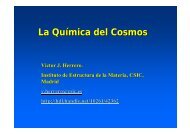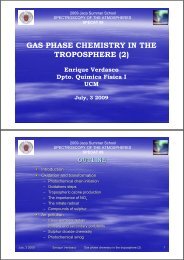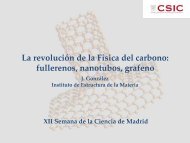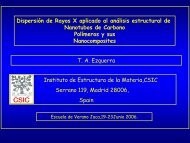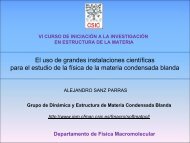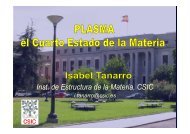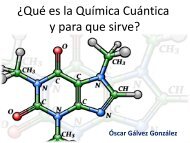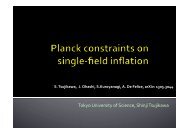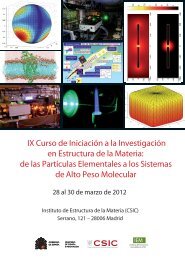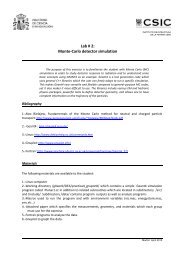PHYSICAL BEHAVIOR AT NANO-SCALESProbably molecu<strong>la</strong>r hydrogen (H 2 ) is the most obvious candidate to rep<strong>la</strong>ce the fossil fuels as an energy vectorenvironmentally neutral. A safe and efficient H 2 storage presents, however, a series of unsolved technologicalchallenges. One possible solution is the adsorption of H 2 at low temperatures in light nanostructured materials.However, practical limitations impose a minimum temperature of 77 K (air liquid temperature) and a maximumpressure around 50 atmospheres. These are very challenging thermodinamical conditions. Above 33 K molecu<strong>la</strong>rhydrogen is in a supercritical state, that is, it is a fluid than cannot be con<strong>de</strong>nsed. In other words, the thermodynamicstate is such that weak (dispersive) interactions, i.e., interactions comparable to those acting between the moleculesthemselves so that there is not a breakdown of the chemical molecu<strong>la</strong>r bond (chemisorption), it is not possible toretain a substantial quantity of molecules on the adsorvent substrate. Since the retention of the molecules by meansof chemical bonding (chemisorption) implies temperatures for the hydrogen release too high for the practica<strong>la</strong>pplications, it is compulsory to find microscopic mechanisms of molecu<strong>la</strong>r trapping going beyond those present inconventional sorbents.By means of a concurrent use of neutron scattering techniques and adsorption measurement, we have been able toi<strong>de</strong>ntify novel mechanisms that contribute to a substantial increase of the hydrogen storage capacity of thecorresponding substrates. More specifically, we have observed a kinetic trapping process of the H 2 molecules incertain carbonaceous tubu<strong>la</strong>r bundles. During the filling process, the structure expands so that on one hand itsnominal capacity increases as the pressure increases, while, on the other hand, the molecules get kinetically trappedin the structure so that an excess of particles are retained in the structure when the pressure is <strong>de</strong>creased, giving riseto a hysteresis loop in the adsorption/<strong>de</strong>sorption process.Following the same rational we started to study materials based in graphite oxi<strong>de</strong>. We have succee<strong>de</strong>d in theinterca<strong>la</strong>tion of simple molecules so that it is possible to “tune” the inter<strong>la</strong>yer space as well as the tortuosity of thepores among the “pil<strong>la</strong>rs”. We hope in such a way to <strong>de</strong>velop efficient materials in trapping interesting molecu<strong>la</strong>rspecies, in particu<strong>la</strong>r H2.MICROSOCPIC STRUCTURE AND DYNAMICS OF DISORDERD CONDENSED MATTERThe wealth of microscopic structures of con<strong>de</strong>nsed matter goes far beyond traditional crystalline phases (or<strong>de</strong>redsolid), g<strong>la</strong>ss (disor<strong>de</strong>red solid) and liquid (fluid). Even simple molecu<strong>la</strong>r substances such as small chain monohydricalcohols (methanol, ethanol, propanol ...) have phases with different types of spatiotemporal or<strong>de</strong>r in different<strong>de</strong>grees of freedom. Probably, the most notable example is the ethanol in which apart from the conventional crystal,g<strong>la</strong>ss and liquid phases, can take a orientational g<strong>la</strong>ss phase with trans<strong>la</strong>tional <strong>de</strong>grees of freedom arranged in a bcccrystal while the orientational ones are in a disor<strong>de</strong>red g<strong>la</strong>ssy phase. These orientational <strong>de</strong>grees may in turn "fuse"at a certain temperature and rotate around the molecu<strong>la</strong>r centers of mass or<strong>de</strong>red in the crystalline structure. In thiscontext, making recourse of the neutron diffraction techniques, we are studying the kinetic of the transition betweenthe bcc rotator phase (p<strong>la</strong>stic crystal) and the conventional monoclinic crystal as a function of temperature.ADVANCED INSTRUMENTATION DEVELOPMENT FOR NEUTRON SOURCESIn recent years much of the work in this area <strong>de</strong>veloped by the group has been focused on the Spanish candidature tothe European Spal<strong>la</strong>tion Neutron Source (ESS-Bilbao). Within this respect, on May 2009 an inflexion point wasreached after an informal agreement in Bruxels in favor of the Swedish site proposal (Lund) and the subsequentagreement between the Spanish Science and Innovation Ministry and the relevant Swedish. As a consequence theESS-Bilbao Consortium (Central Administration / Basque Country Government) has refocused its activities nowun<strong>de</strong>r the direction of Prof. Javier Bermejo. More specifically, the ongoing activities are aimed at building a localinfrastructure based on a high power light ion accelerator in or<strong>de</strong>r to provi<strong>de</strong> service to advanced experimentalprograms not only in the production of neutron beams by nuclear fragmentation processes (spal<strong>la</strong>tion) but in areas asdiverse as particle physics, the study of materials for nuclear fusion, unstable isotopes production for nuclear physicsstudies or possible applications of this kind accelerators in radiation oncology. Three are the main objectives thecenter:- To serve as a center for <strong>de</strong>sign, <strong>de</strong>velopment and prototyping of some acceleration structures responsible for theneutron beam energy gain up to about 2.5 GeV.- To nucleate in our system of Science-Technology-Innovation, a <strong>la</strong>boratory specializing in science and technologyof high power accelerators, comparable with those in the surrounding countries involved in the <strong>de</strong>velopment andcoordination of international <strong>la</strong>rge facilities.- To provi<strong>de</strong> to our industrial sectors tools to position themselves advantageously in areas requiring the use of lightion beams (high power semiconductors, aerospatial industry, lithography, ultra-hard materials).60
Apart from the center for accelerators, it is also un<strong>de</strong>r construction the instrument WISH (second target station ofISIS facility) in which we are involved in several of its components as well as the <strong>de</strong>velopment of an update forPEARL (first target station ISIS facility) an instrument specialized in sample environments at extreme pressures.PREPARATION OF METAL NANOPARTICLESThe preparation of metal nanoparticles (NPs) with p<strong>la</strong>smonic properties has been a priority line of the group duringthis period. We have <strong>de</strong>voted special attention to the NPs with morphologies that lead to high electromagnetic fiel<strong>de</strong>nhancements. To accomplish this, it has been established experimental conditions that lead up to this kind ofmorphologies. The strategy followed to prepare these systems was: a) Fabrication of NPs giving rise to highelectromagnetic field intensities, like triangu<strong>la</strong>r nanoprisms and nanostars; and b) the association of spherical NPsby using bifunctional molecules that lead to the formation of highly effective interparticle cavities or hot spots,where the Raman scattering is markedly enhanced. Different preparation protocols were assayed in or<strong>de</strong>r to improvethose already <strong>de</strong>scribed in the literature. To carry out this task bifunctional molecules as diamines, dithiols, aliphaticdicarboxy<strong>la</strong>tes and aromatic dithiols have been used. The characterization of all these systems was carried out bymeans of P<strong>la</strong>smon resonance, TEM, SERS and SEF.In this line, we have procee<strong>de</strong>d to the fabrication of mixed metal systems core/shell, which combines the p<strong>la</strong>smonicproperties of both metals, preserving the characteristics of the metal surface to the outer <strong>la</strong>yer. For instance we havesuccessfully manufactured Ag/Au and Pt/Au systems by reduction of Ag and Pt on Au nanoparticles, respectively.These systems are characterized by p<strong>la</strong>smon resonance, microscopy (TEM, SEM and AFM), and SERS. The use ofmolecu<strong>la</strong>r markers or sensor systems, which are adsorbed through a different mechanism on the different metal outer<strong>la</strong>yer, has yiel<strong>de</strong>d valuable information about the distribution of metals in the resulting particles and <strong>de</strong>termine theireffectiveness in SERS.Also, within this line, we have carried out the nanofabrication of core/shell systems consisting in magneticnanoparticles coated with Ag and Au, thus resulting systems where the metal p<strong>la</strong>smonic properties used to cover(shell) are combined with the magnetite magnetic properties of the core. These systems have been characterized byspectroscopic techniques like UV-visible absorption, IR and Raman microscopy, TEM, X-ray diffraction andmagnetization measurements.SURFACE FUNCTIONALIZATION: NANOSENSORSAs in previous years, an important part of the work done in our group during 2010 was <strong>de</strong>voted to thefunctionalization of metal surfaces obtained by self-assembly of organic molecules. The functionalization cansignificantly increase the sensitivity and selectivity of the nanostructures formed, thus obtaining the highperformancesurfaces by combining the physical properties of the metal substrate with the chemical properties oforganic molecules self-assembled on them. Additionally, these molecules may lead to a biocompatibility of theseNPs, what is in turn advantageous for different medical applications, and to govern the self-assembly of these NPs.Functionalization with host or receptor molecules such as calixarenes and cyclo<strong>de</strong>xtrins has been possible thanks tothe inclusion in these moleculesof chemical groups disp<strong>la</strong>ying a high affinity for metal surfaces such as the groupdithiocarbamate (DTC). The DTC group has a high affinity for Au and Ag, which has enhanced the efficiency of thefunctionalization, resulting in metal systems/assembler with high performance in <strong>de</strong>tecting contaminants, for illicitdrugs and doping in sport. The <strong>de</strong>tection of these analytes is possible by the existence of hydrophobic cavities inthese hosts, in which the molecules to be <strong>de</strong>tected can be accommodated. Recently, we have started to use other kindof inclusion hosts: the cucurbiturils, applied in the <strong>de</strong>tection of pestici<strong>de</strong>s.Another group of molecules previously used in the functionalization of metal surfaces, the viologens, whose activityis re<strong>la</strong>ted to their host properties as electron acceptor, were used in the <strong>de</strong>tection of contaminants such polycyclicaromatic hydrocarbons, which act as electron donors. The viologen interact strongly with the metal through ion-pairor charge transfer complexes between viologen and previously attached to the metal hali<strong>de</strong>. During this periodlucigenin was applied in multivariate <strong>de</strong>tection. The huge selectivity of lucigenin and the SERS spectra may lead toa univocal i<strong>de</strong>ntification in mixtures of pollutants. In particu<strong>la</strong>r, this was assayed in mixtures of polycyclic aromatichydrocarbons. The bifunctional viologen dramatically improves the performance of these substances to act ascreators of interparticle spaces with high electromagnetic field enhancement (hot spots), and also by acting ascontact assemblers. This work was ma<strong>de</strong> in the frame of an Associated Unit with the University of Ma<strong>la</strong>ga.Finally we have studied the functionalization molecules using bifunctional molecules with aliphatic character(diamines, dithiols and aliphatic dicarboxy<strong>la</strong>te), as well as with aromatic character (phenilene dithiols anddiisocyani<strong>de</strong>s). The <strong>la</strong>st compounds are also able to induce the formation of hot spots by NP-NP associations, withhigh performances in the <strong>de</strong>tection and catalysis of substrates localizaed insi<strong>de</strong> these cavities. All these works were61
- Page 3:
INTRODUCCIÓNEl Instituto de Estruc
- Page 10 and 11: Dra. Maria Esperanza Cagiao Escohot
- Page 12 and 13: TALLER ÓPTICOD. José Lasvignes Pa
- Page 14 and 15: 2A.1 DPTO. DEQUÍMICA YFÍSICA TEÓ
- Page 16: empezar a caer. Este fenómeno se e
- Page 19 and 20: Existen varias diferencias entre la
- Page 21 and 22: Estudio de las propiedades estructu
- Page 23 and 24: poblar los estados de interés en 1
- Page 25 and 26: Si bien la técnica TF está bien e
- Page 27 and 28: que no se produzca la ruptura de en
- Page 30 and 31: antitumoral emodina mediante el efe
- Page 32 and 33: Esta formulación ha sido desarroll
- Page 34 and 35: oooooCriogenia.Espectroscopía Rama
- Page 36 and 37: FLUIDODINÁMICA MOLECULAREl princip
- Page 38 and 39: También se ha concluido y publicad
- Page 40 and 41: o Análisis mecánico en tracción:
- Page 42 and 43: cuerpo (BCC), tiene lugar la formac
- Page 44 and 45: BIOSAXSCaracterización de coloides
- Page 46 and 47: Sin embargo, desde el punto de vist
- Page 48 and 49: 2B.1 THEORETICAL PHYSICS AND CHEMIS
- Page 50 and 51: terms and that b) stellar pulsation
- Page 52 and 53: We have investigated transport thro
- Page 54 and 55: een proposed as possible interstell
- Page 56 and 57: The figure shows a compilation of t
- Page 58 and 59: oppositely aligned spins. This pair
- Page 62 and 63: done in collaboration with research
- Page 64 and 65: Finally, we have also conducted a w
- Page 66 and 67: species have been obtained from tim
- Page 68 and 69: Rideal mechanism, with a preference
- Page 70 and 71: Liquid hydrogen filament (5 micron
- Page 72 and 73: Nanostructure of polymer thin films
- Page 74 and 75: morphological model for Natural Rub
- Page 76 and 77: product. The clay can be used direc
- Page 78 and 79: with the extracellular ERBBs domain
- Page 80 and 81: 3.1 DPTO. DEQUÍMICA YFÍSICA TEÓR
- Page 82 and 83: Duration: January 2010-December 201
- Page 84 and 85: Objectives: This Project aims at ob
- Page 86 and 87: Funding Institution: Comunidad de M
- Page 89 and 90: CAPÍTULO 4COOPERACIÓN CIENTÍFICA
- Page 91 and 92: 4.1.3 DPTO. DE FÍSICA MOLECULAR /
- Page 93 and 94: o Complete Hybrid Quantization of a
- Page 95 and 96: R3B Collaboration Meeting, Darmstad
- Page 97 and 98: SERS Roundtable 2011, Poltersdorf (
- Page 99 and 100: International Conference on Process
- Page 101 and 102: 4.3. ESTANCIAS DE INVESTIGADORES EN
- Page 103 and 104: Dr. Francesca Vidotto.Université d
- Page 105 and 106: 4.4.3 DPTO. DE FÍSICA MOLECULAR /
- Page 107: Guillermo Ribeiro Jiménez. Subatom
- Page 110 and 111:
5.1 DOCENCIA / TEACHING5.1.1 DPTO.
- Page 112 and 113:
5.1.3 DPTO. DE FÍSICA MOLECULAR /
- Page 114 and 115:
5.2.3 DPTO. DE FÍSICA MOLECULAR /
- Page 116 and 117:
Óscar Gálvezo Hielos y Plasmas de
- Page 118 and 119:
Olof Tengblad- Deputy Technical Man
- Page 120 and 121:
5.5 ACTIVIDADES Y MATERIAL DE DIVUL
- Page 122 and 123:
Plasma, el cuarto estado de la mate
- Page 124 and 125:
5.7 UNIDADES ASOCIADAS Y OTRAS ACTI
- Page 126 and 127:
oScientific collaboration on “Din
- Page 128 and 129:
6.1 PUBLICACIONES EN REVISTAS Y PRO
- Page 130 and 131:
Prescriptions in Loop Quantum Cosmo
- Page 132 and 133:
Richardson-Gaudin Models: The Hyper
- Page 134 and 135:
79. L. Guerrini, S. Sanchez-Cortes,
- Page 136 and 137:
Probing the Nature of Particle-Core
- Page 138 and 139:
PROCEEDINGS ISI /ISI PROCEEDINGS120
- Page 140 and 141:
Physical Review Letters 106, 245301
- Page 142 and 143:
Conducting Nanocomposites Based on
- Page 144 and 145:
3. O. S. Kirsebom, S. Hyldegaard, M
- Page 146 and 147:
6.4 TESIS DOCTORALES / Ph. D. THESE
- Page 149 and 150:
CAPÍTULO 7TABLAS Y DATOSCHAPTER 7T
- Page 151 and 152:
Spectrochimica Acta B 2 3.552Chemph
- Page 153 and 154:
7.4 PERSONAL POR DEPARTAMENTOS /PER
- Page 155 and 156:
ÍNDICEINDEX155
- Page 157 and 158:
4.1.2 Dpto. de Espectroscopía Nucl
- Page 159:
6.2.2 Dpto. de Espectroscopía Nucl




